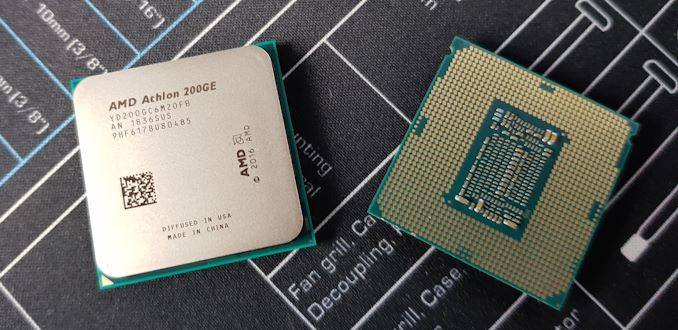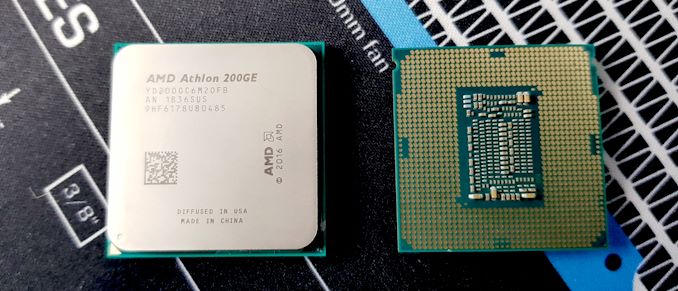The $60 CPU Question: AMD Athlon 200GE or Intel Pentium Gold G5400? A Review
by Ian Cutress on January 14, 2019 8:00 AM EST
In the course of our reviews, when we get a chance to get hands on with random processors, we run our test suite and add the data to our database. Sometimes that doesn’t materialize directly into a review, but at least we have the data. Two very similar CPUs have come across my desk recently: AMD’s dual core Athlon 200GE, and Intel’s Pentium G5400. Both chips round to the $60 mark, have some form of integrated graphics, and are aimed at budget systems.
This is going to be fun
One of the perennial issues with modern technology review cycles is that there’s a lot of focus on the high-end parts. These are the ones that the manufacturers sample: they have the highest margins, but are also the halo products: if they sit atop of the standings, then the hope is that that influence will trickle down into the rest of the product range, typically the high-volume parts. There is also the added benefit that more people want to hear about the best of the best. It’s a reason why there are so many Ferrari and Aston Martin ‘WOW’ pieces in written and video media.
Normally this would make sampling very difficult. If we were reviewing cars, anyway. The two chips in today’s analysis, the Intel Pentium Gold G5400 and the AMD Athlon 200GE, cost around $60 apiece, which I forked out for personally as I was never expecting to be sampled. (AMD asked if I wanted a 200GE sample two days after my retail unit arrived, go figure. I sent that on to Gavin for his 7-year old’s new gaming system.)
| AMD vs Intel at ~$60 | ||
| AMD Athlon 200GE |
Intel Pentium Gold G5400 |
|
| Cores / Threads | 2 / 4 | 2 / 4 |
| Microarchitecture | Zen | Coffee Lake |
| Motherboards | X470, X370, B450 B350, A320, A300 |
Z390, Z370, Q370 H370, B360, H310 |
| CPU Frequency | 3.2 GHz | 3.7 GHz |
| L2 Cache | 512 KB/core | 256 KB/core |
| L3 Cache | 2 MB / core | 2 MB / core |
| Integrated Graphics | Vega 3 192 SPs |
UHD 610 12 EUs (96 ALUs) |
| DDR4 Support | DDR4-2933 | DDR4-2666 |
| GPU Frequency | Up to 1000 MHz | 350-1050 MHz |
| TDP | 35 W | 54 W (2-core die version) 58 W (4-core die version)* |
| Price | $55 (SRP) | $64 (1k/u) |
| * Intel harvests both 2+2 and 4+2 dies to make G5400 parts. It's impossible to know which one you have without removing the lid and measuring the die area. | ||
When we stack up the two processors side by side, it gets interesting. Both are dual core, quad thread parts. The Intel processor has the frequency advantage, running at 3.7 GHz compared to the 3.2 GHz of AMD, but the AMD has beefier Vega 3 integrated graphics compared to the UHD 610 (GT1) graphics of the Intel chip. One sore point might be the TDP, where the AMD chip has a rating of 35W and the Intel chip is rated at 58W, however as we’ll see in the review, neither of them come close to those values.
Tackling the budget end of the market is fun. I’ve been a long-time advocate for budget builders to build a system piece-by-piece, getting one high-end part at a time rather than smearing a budget across several average parts at once. Under this philosophy, these processors could very well be the start of one of those builds, only costing an average of $60 MSRP. Note that under this philosophy, you might end up with that big graphics card before a processor that can power it. We’re covering those benchmarks as well.
Before you click further, place your bets on who you think will win: the Intel Pentium Gold G5400, or the AMD Athlon 200GE?
Latest News: While neither processor is officially overclockable, since we tested for this article it was recently reported that MSI motherboards with certain BIOS versions will allow users to overclock the 200GE to ~3.9 GHz. I've asked Gavin to contribute, and he managed a nice 3.9 GHz over the 3.2 GHz base clock. Head over to page 21 for the details.
Pages In This Review
- Analysis and Competition
- Test Bed and Setup
- 2018 and 2019 Benchmark Suite
- CPU Performance: System Tests
- CPU Performance: Rendering Tests
- CPU Performance: Office Tests
- CPU Performance: Encoding Tests
- CPU Performance: Legacy Tests
- Gaming: Integrated Graphics
- Gaming: World of Tanks enCore
- Gaming: Final Fantasy XV
- Gaming: Shadow of War
- Gaming: Civilization 6
- Gaming: Ashes Classic
- Gaming: Strange Brigade
- Gaming: Grand Theft Auto V
- Gaming: Far Cry 5
- Gaming: Shadow of the Tomb Raider
- Gaming: F1 2018
- Power Consumption
- Overclocking
- Conclusions and Final Words











95 Comments
View All Comments
Ratman6161 - Monday, January 14, 2019 - link
One issue is though that at my favored place to buy CPU's (microcenter.com) The 2200G isn't $40 more, its only $30 more. The 200GE is $49.99 and the 2200G is $79.99. Add to that you can get a B450 motherboard for $59.99. So for just $30 more for the total system price and the fact that the 2200G/B450 combo guarantees overclocking capability, I couldn't really see going with either of the CPU's in this review.eastcoast_pete - Monday, January 14, 2019 - link
Fully agree, and, at those prices (2200G at $ 79.99, plus mobo for $59.99), it's even more a closed and shut case. Neither the Athlon nor the Pentium come anywhere near the 2200G, especially if the iGPU is "it", which is likely for a budget system. The only scenario I can see for a builder to chose the Athlon or the Pentium is if they a. are on sale, and b. if it's for one's parents or grandparents, and all they want to do is browse the web and some occasional light office work. But, even there, if one can swing the extra $30, why not get the much more capable 2200G? With the added ability to play some games, maybe you'll visit more often (:GreenReaper - Tuesday, January 15, 2019 - link
I was thinking this throughout - "wow, this review is a great advertisement for the 2200G!"Personally I'd like to wait for a chip with AV1 support, Navi and PCIe 4.0, but it seems likely that you'll be able to upgrade to all of that at a later date if you pick your motherboard right.
DominionSeraph - Monday, January 14, 2019 - link
Can you put the venerable i5 2500 in the new Bench? With used systems available for $90 it's the price/performance champion.jordanclock - Monday, January 14, 2019 - link
On the Overclocking page:"In recent weeks, motherboard manufacturers have been releasing BIOS firmware that enables overcooking on the Athlon 200GE."
I know OCing can increase temperatures, but calling it overcooking might be a little strong.
mczak - Monday, January 14, 2019 - link
Ian,I think you might want to rephrase every paragraph which has "AVX" in it. From your wording it sounds like you're surprised the pentium doesn't benefit much from the use of AVX, whereas the truth is it doesn't support AVX at all, hence even if you use avx-optimized binaries it's still going to use an sse-only path.
This is of course a reversal of the other Core chips vs. Ryzen - intel typically benefits quite a bit more from AVX code, since it actually has simd units which are physically 256bit wide, whereas Ryzen only has simd units which are 128bit wide.
GreenReaper - Tuesday, January 15, 2019 - link
I agree, I was a little confused when I saw talk of AVX for the Pentium - don't get me wrong, SSE optimizations can provide great benefits (compare 'openssl speed -evp' to 'openssl speed' on a Celeron), and probably they are used by the "optimized" path but it's not going to give the same results.As you say, "supports" is debatable on Ryzen. But even if a CPU didn't really support it on a hardware level at all (which is not the case), its use might result in improvements due to the ability to provide a microcode equivalent than is faster than the SSE-based alternatives.
silverblue - Tuesday, January 15, 2019 - link
It's not really debatable in my eyes - it may be half-speed, but there's no AVX offset - as far as I can tell - to worry about. When Zen 2 pops up, perhaps it'll have to behave more like Intel's implementation.eastcoast_pete - Tuesday, January 15, 2019 - link
Agree. After all, in the Intel universe, the absence of AVX is a key differentiator between the Pentium and the core i3; if you want hardware-supported AVX extensions, you have to fork over the extra $$$ and get at least the entry-level core chip.kkilobyte - Monday, January 14, 2019 - link
I'd like to know where one would find the G5400 at 60$, or even at the same price as the 200GE.I don't seem to be able to find the G5400 in Europe for less than 75€. On the other hand, I can get a 2000GE at 55-60€.
For example, Materiel.net - one of the most popular online shops in France and Belgium, has the cheapest Intel i3, the G4900, at 67.95€, while the 200GE is 57.95€. And the G5400? They list it as 'out of stock', at more than 100€ (!)
If both where at the same price, indeed, the Intel CPU would be more interesting. But if it's either unavailable or 20-50% more than the price given in the article, what's the point?